VET APPROVED

The information is current and up-to-date in accordance with the latest veterinarian research.
Learn more »Click to Skip Ahead
If this is your first time presiding over a cat in labor and you’re unfamiliar with the signs, it can be tricky to know precisely when the birthing process is over. On average, cats are in labor for between 4 and 16 hours, but it can take longer in some cases and give birth to 4–6 kittens, but sometimes more or less.
In this post, we’ll reveal the signs that your cat may have finished giving birth or is nearing the end of the process so you know what to look for when the time comes.

The 6 Signs That Cat Labor Is Over
1. Nursing and Grooming the Litter
After each kitten is born, the mother typically gives them a quick cleaning to clear their nose and mouth and remove them from the amniotic sac if they are still inside it at that point (you’ll have to do this if she doesn’t do it herself). This resting phase between kittens typically lasts 10 minutes to an hour, but it sometimes lasts up to 4 hours.
However, when the cat is nearing the end of labor or has finished the process, she will focus on grooming her entire litter more thoroughly and bonding with them. The kittens should also start to suckle from her.
On rare occasions, some queens go through what is known as interrupted labor, a resting stage of 24–36 hours between the births of the first kittens and the rest of the litter. Interrupted labor is normal. After delivering some kittens, the queen will stop straining, take a rest, feed the newly born kittens, and even eat and drink. This occurs even though she still has more kittens to deliver. After the resting stage, the straining commences and the remainder of the litter is born normally.
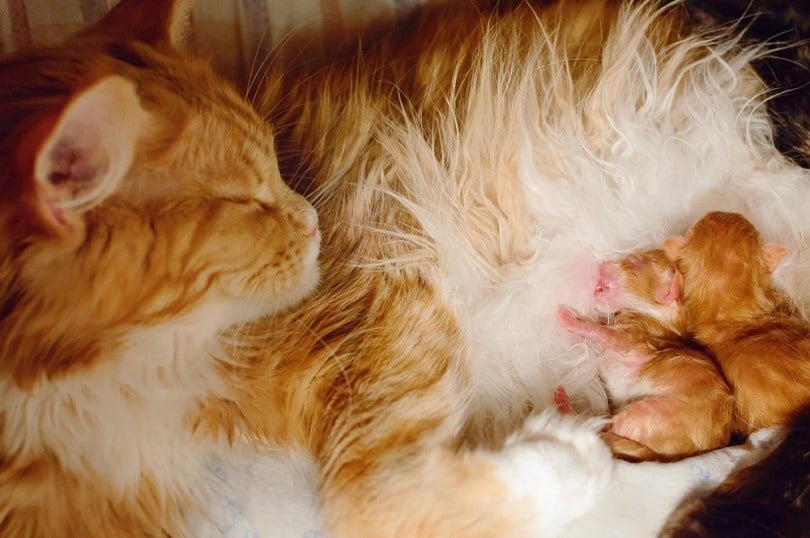
2. She’s Calm
Before giving birth, cats often become restless and agitated. While in labor, the mother has contractions that cause her to strain, pant, cry out, and yowl because, simply put, she’s having a pretty rough time. When she’s done giving birth, she will become much more serene, content, and focused on her newborns.
She needs plenty of rest and space to bond with her litter. You can help by providing her with a calm, quiet, and comfortable space to give birth in and spend time after the birth. Kittening/nesting boxes are great for this purpose.
3. She’s Breathing Normally
During labor, the mother will breathe heavily (pant) and quickly from the effort she has to exert. If she’s still panting at any stage during labor, she likely hasn’t yet finished giving birth. If, however, her breathing has returned to normal, she may be done.
We use the word “may” because, as mentioned, there are sometimes resting phases between the birth of each kitten or several kittens at once. During these resting phases, the mother may seem completely calm and content, but the birth may not be over yet.
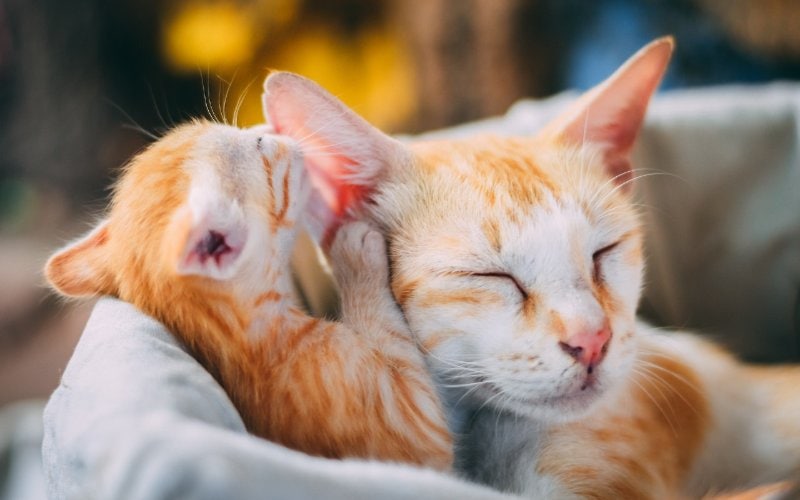
4. A Few Hours Have Passed Without a Kitten
Resting phases between kitten births last 10 minutes to an hour, but they can last up to 4 hours in some cases, and the labor process can even extend up to 36 hours. If a few hours have passed since the birth of the last kitten, and your cat is calm, relaxed, and resting or attending to her litter, she might have finished giving birth.
However, if your cat has been straining for more than 20–30 minutes without giving birth to a kitten, contact your vet immediately since it could be an issue preventing the kitten from being born.
She may have interrupted her labor if you can still see movement in the cat’s belly.
5. All Placentas Have Been Passed
Placentas are usually expelled around 15 minutes after a single kitten or two or three kittens at once are born. If a placenta or placentas are not passed within 15 minutes, there could be more kittens to come.
Another possible reason for this is a stuck placenta. If the placenta doesn’t appear in a timely manner, you should contact your vet in case it’s stuck inside the uterus.
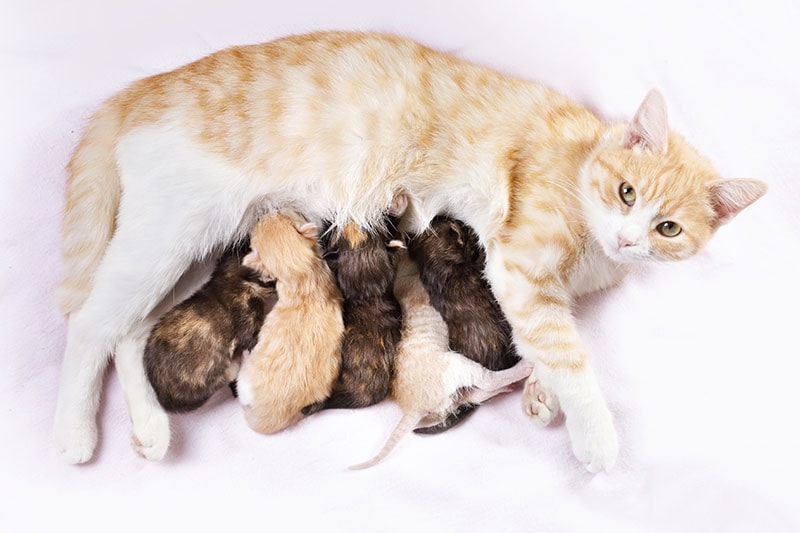
6. The Mother Is Hungry
In the hours following labor, the mother cat may regain her appetite. Some cats start eating again shortly after labor, but some refuse food for up to 24 hours. This is normal, so don’t worry.

Signs of Birthing Complications
The medical term for difficult birth is dystocia. Dystocia can be caused by several issues, including (but not limited to) a fetus that’s too large or has an abnormal posture and uterine inflammation. Below are some of the signs of dystocia. Please get in touch with your vet if you spot any of these signs:
- Bleeding (more than just a few drops)
- Straining for 20–30 minutes without giving birth to a kitten
- More than 2 hours have passed between births (the resting phase can last up to 4 hours, but contact your vet after the 2-hour point to be on the safe side)
- It takes more than 4 hours since stage two of delivery started to produce a kitten
- Your cat’s rectal temperature dropped below 99 degrees Fahrenheit, but they haven’t gone into labor within 24 hours of this point
- Bloody discharge before the first kitten is born or between births
- Green discharge
- Foul-smelling discharge
- The cat panics during the first stage, and the birthing process stops (hysterical inertia)
- Stopping straining due to exhaustion
- Failing to give birth to a kitten that’s stuck halfway out
- Constant licking of the vulva during contractions
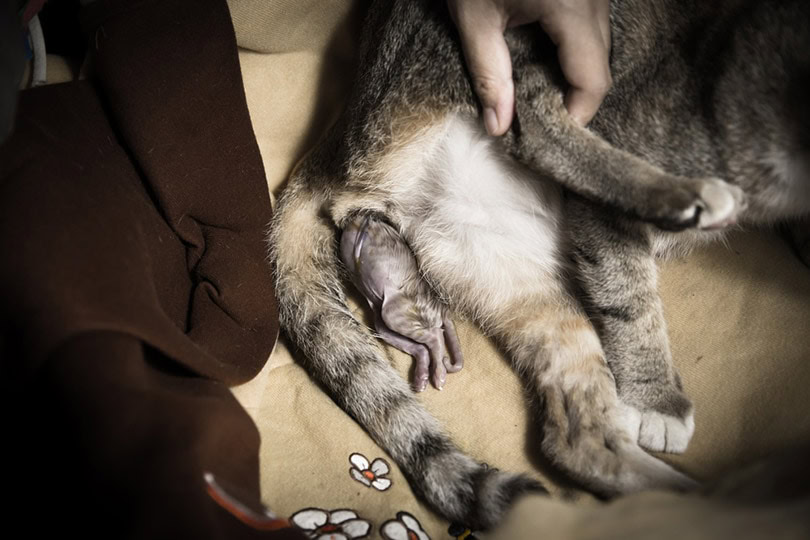

Preparing for Cat Labor
Unless there’s a problem (like, for example, the mother doesn’t remove a kitten from a sac or a kitten is stuck on the way out), you’ll only need to observe while your cat gives birth, but let her do her thing in peace. However, you must contact a vet if something seems wrong. Here are some ways you can help prepare your cat for giving birth.
Prepare a Nesting Box
The nesting box must be spacious enough for your queen and her kittens. It’s best to add a towel or another absorbent material to the box. Nesting boxes provide a private, quiet spot to give birth and care for her kittens after birth. Give your cat time to get used to this box before she gives birth.
Keep Your Cat Calm
Your cat should be kept as calm and stress-free as possible leading up to the birth. Place her nesting box or chosen birthing area away from areas with loud noises or where a lot is going on. Don’t be surprised if your cat becomes clingier than usual prior to giving birth—this is normal. You can soothe her by giving her lots of attention and love.
Feed an Appropriate Diet
Pregnant cats can be switched to high-quality kitten food because it contains more protein and calories. Speak to your vet if you’re unsure which food is best for your cat.

Be Ready with a Vet’s Contact Details
As a precaution, before your cat gives birth, do your research and have a vet’s contact details on hand in case you need to call them quickly. Having an emergency vet’s phone number on hand is ideal if your cat gives birth outside of regular working hours and there’s a problem. You can also connect with a vet prior to delivery to ensure that you are fully prepared for the journey to come!

Final Thoughts
The principal signs that a cat’s labor has ended are a calm, relaxed demeanor and the mother tending conscientiously to the litter. However, in some cases, labor can be delayed either by interrupted labor, a resting phase between births, or a medical issue, and these factors can make it difficult to tell when the labor is truly over.
Keep a close eye on your cat during labor, and if they strain for 20–30 minutes without giving birth or show other signs that something isn’t right (such as excessive bleeding, green or foul-smelling discharge, etc.), contact your vet immediately.
- https://www.petmd.com/cat/conditions/reproductive/c_ct_dystocia
- https://icatcare.org/advice/difficult-cat-birth/
- https://www.cronullavetclinic.com.au/when-your-cat-is-in-labour/
- https://petsbeam.com/how-do-you-know-a-cat-is-done-giving-birth-answers-here/
- https://vcahospitals.com/know-your-pet/pregnancy-and-parturition-in-cats
- https://www.pdsa.org.uk/pet-help-and-advice/pet-health-hub/other-veterinary-advice/cat-labour-a-guide-to-your-cat-giving-birth
- https://upgradeyourcat.com/how-to-tell-when-a-cat-is-done-giving-birth/#Check_for_Contractions
- https://www.wikihow.com/Tell-if-a-Cat-Still-Has-Kittens-Inside
- https://www.sylvanpets.com/how-do-you-know-your-cat-is-ready-to-deliver-her-litter-of-kittens#:~:text=Her%20Contractions%20Begin&text=You%20can%20usually%20see%20or,loving%20and%20needy%20than%20usual.
- https://www.rochesterhillsvet.com/articles/normal_labor_and_delivery_in_the_cat.php#:~:text=After%20delivery%20of%20the%20kitten,more%20kittens%20will%20be%20delivered.
- https://vcahospitals.com/know-your-pet/feeding-the-pregnant-cat
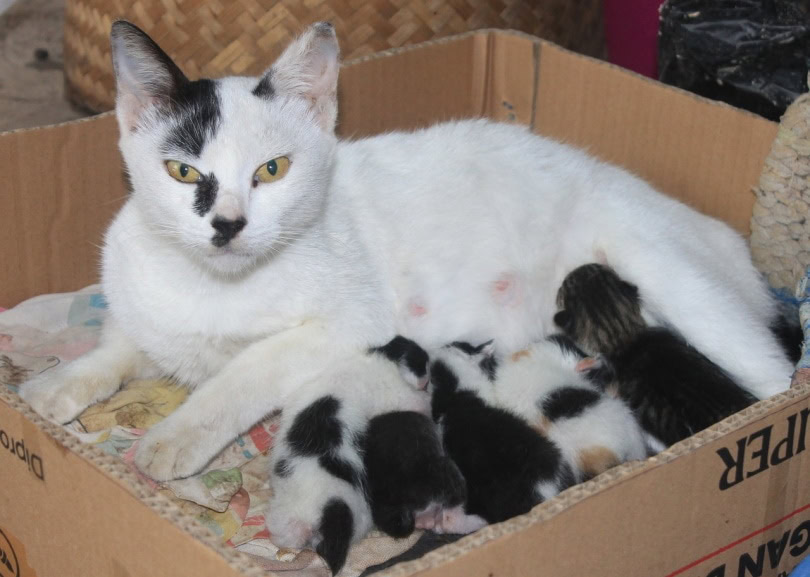






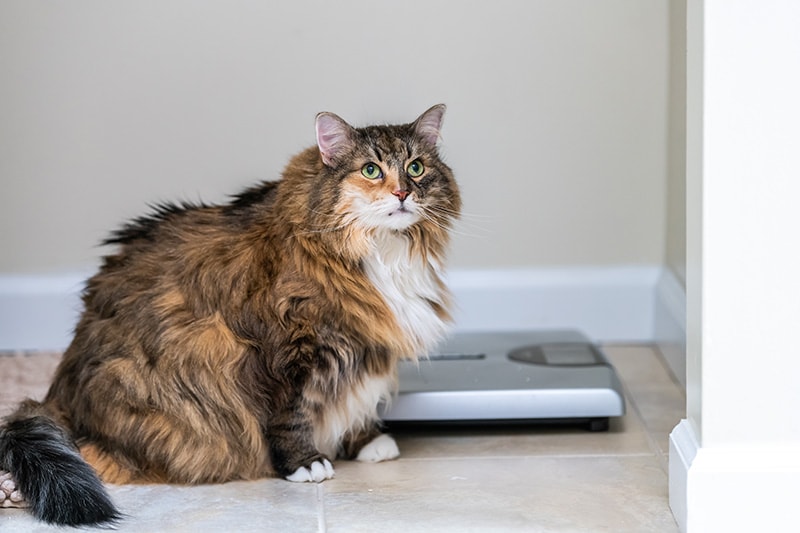
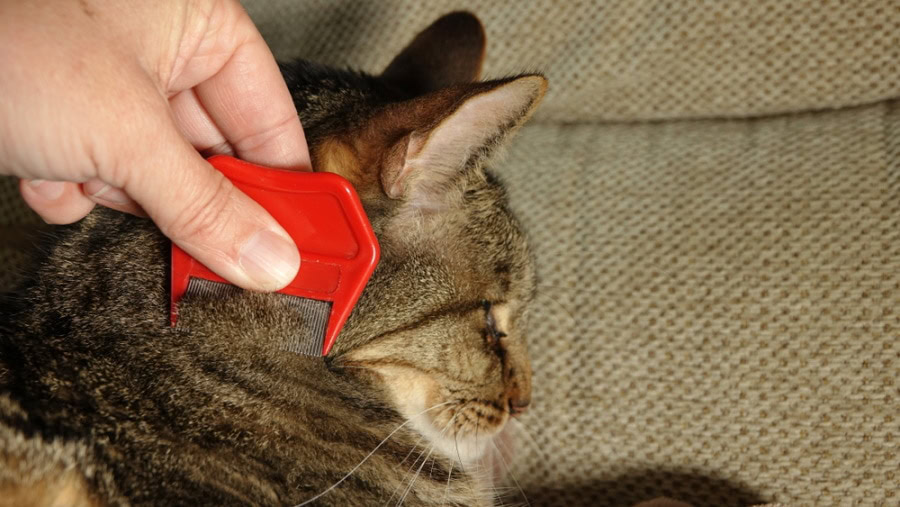
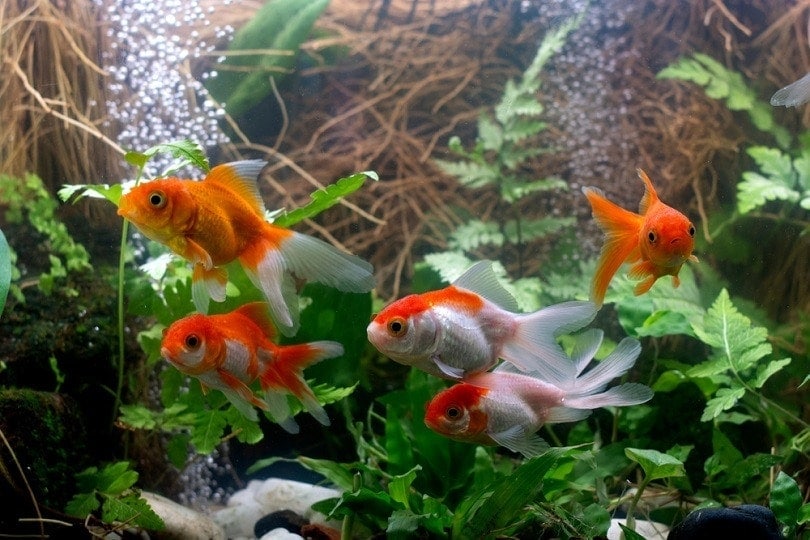



3 Responses
Thank you for this helpful guide! Understanding the signs of when cat labor is over is crucial for ensuring both mom and kittens are healthy. I appreciate the clear explanation and tips for monitoring the process. Great resource for pet owners!
Hello Jesse,
thank you very much for your nice feedback. We agree that recognizing your cat is in labor is essential. You can immediately start to care for her as you should when she is in this condition. We are glad you found this information helpful.
Have a nice day!
Thank You, Radim
and a blessed day for you too